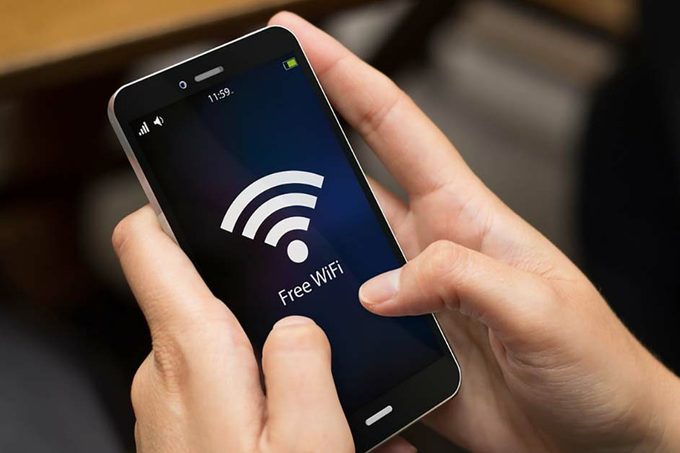If you think Wi-Fi stands for "wireless fidelity," think again

What Does Wi-Fi Stand For?

Long gone are the days of dial-up and waiting for your turn to use the computer. Today, it’s easier than ever to connect to the internet, and that’s mostly thanks to Wi-Fi. You’ve almost certainly used it. You likely know what it does. But here’s the million-dollar question: What does Wi-Fi stand for?
We talked to a tech expert to get the details. Read on for a quick rundown of what Wi-Fi stands for, what it is exactly and other misconceptions you might have about this wireless technology.
Get Reader’s Digest’s Read Up newsletter for more tech, travel, cleaning, humor and fun facts all week long.
What is Wi-Fi?
Wi-Fi is a wireless network that uses radio frequency signals to connect to the internet or send messages between devices without the need for wires. Everything from your phone and laptop to tablets and printers can use Wi-Fi. Think of it like a highway that connects your whole house to the internet, letting multiple devices stream, browse or work all at once over longer distances.
But can you have Wi-Fi without the internet? Surprisingly, you can. Miranda Yan, founder of VinPit, says you can use a Wi-Fi dongle to connect to the internet. Or you can set up a personal hot spot, tether your smartphone to your computer with a USB cable or connect to public Wi-Fi at places like restaurants, coffee shops, hotels and even doctors’ offices.
What does Wi-Fi stand for?

The term doesn’t actually stand for anything. Wi-Fi is a trademarked term used to describe devices or technology based on the Institute of Electrical and Electronics Engineers’ (IEEE) wireless communication standard 802.11, according to the Wi-Fi Alliance. That’s a mouthful, so the Wi-Fi Alliance hired the marketing company Interbrand to come up with another name. The result: Wi-Fi, according to one of the founding alliance members.
There’s some debate surrounding the question “What does Wi-Fi stand for?” The rumor that it stands for “wireless fidelity” originated from the Wi-Fi Alliance. Some members didn’t understand the branding or marketing behind the term and felt that consumers would want an explanation for the name. In the end, the group agreed to include a tagline: The Standard for Wireless Fidelity. Users put two and two together, assuming the word Wi-Fi stood for “wireless fidelity.”
Because the alliance created the tagline after the term Wi-Fi—and later removed the tagline—it’s safe to say “wireless fidelity” didn’t factor into the naming. Still, the confusion it created continues today.
Confusion notwithstanding, it is an undeniable fact that the internet and Wi-Fi changed the world of communication. Now, millions of people can hop online from just about anywhere, instantly connecting with others, sharing ideas and accessing info from all over the world.
What are some other common myths about Wi-Fi?
You’ve likely encountered your fair share of Wi-Fi myths online, and not just the one related to what Wi-Fi stands for. Here are more debunked facts about the can’t-live-without-it technology:
- Myth: Wi-Fi is the same as the internet.
Truth: Wi-Fi is a path to connect to the internet without wires.
- Myth: Wi-Fi signals are bad for your health.
Truth: There have been no conclusive studies that provide evidence of this. The radiofrequency radiation used by Wi-Fi is nonionizing and relatively harmless to humans.
- Myth: Wi-Fi 6 and other newer Wi-Fi technologies are just marketing hype and don’t offer real improvements.
Truth: These advanced wireless technologies provide a significant increase in speed, efficiency and network capacity.
- Myth: Public Wi-Fi is always secure and safe to use.
Truth: Public Wi-Fi networks can be vulnerable to hacking, which makes it easier for malicious users to access your personal data. Taking a few precautionary steps, like using a VPN (virtual private network), is recommended to protect your data on public Wi-Fi networks.
FAQs
What’s the difference between Wi-Fi and Bluetooth?
Both Wi-Fi and Bluetooth are wireless technologies. While Wi-Fi is like a superhighway connecting your devices to the internet, Bluetooth is more like a short walking path—great for quick, close connections like pairing your headphones, tracking your keys or sending a file between two nearby devices.
When was Wi-Fi created?
In 1997, a committee of industry leaders approved a common, more compatible Wi-Fi standard. Two years later, a group of companies formed the Wireless Ethernet Compatibility Alliance (WECA, now the Wi-Fi Alliance). It is a global nonprofit organization created to promote the wireless standard.
Why trust us
Reader’s Digest has published hundreds of articles on personal technology, arming readers with the knowledge to protect themselves against cybersecurity threats and internet scams as well as revealing the best tips, tricks and shortcuts for computers, cellphones, apps, texting, social media and more. We rely on credentialed experts with personal experience and know-how as well as primary sources including tech companies, professional organizations and academic institutions. We verify all facts and data and revisit them over time to ensure they remain accurate and up to date. Read more about our team, our contributors and our editorial policies.
Sources:
- Miranda Yan, founder of VinPit
- Xfinity: “What Is Wi-Fi and How Do I Get It?”
- Britannica: “Wi-Fi”
- Wi-Fi Alliance: “Wi-Fi Generations”
- Wi-Fi Net News: “Wi-Fi Stands for…Nothing (and Everything)”
- Reuters: “No link between mobile phones and brain cancer, WHO-backed study says’























